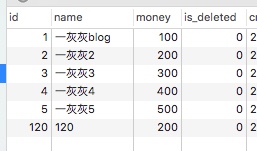「」。

在使用Mybatis开发时,借助xml来写具体的sql,再写传参类型或者返回结果类型时,通常会与ParameterType, ParameterMap, ResultMap, ResultType这四个打交到,那么这个Type与Map到底怎么区别,什么时候要指定类型,什么时候又可以不指定呢?
I. 环境配置
我们使用SpringBoot + Mybatis + MySql来搭建实例demo
- springboot: 2.2.0.RELEASE
- mysql: 5.7.22
1. 项目配置
<dependencies>
<dependency>
<groupId>org.mybatis.spring.boot</groupId>
<artifactId>mybatis-spring-boot-starter</artifactId>
<version>2.2.0</version>
</dependency>
<dependency>
<groupId>mysql</groupId>
<artifactId>mysql-connector-java</artifactId>
</dependency>
</dependencies>
核心的依赖mybatis-spring-boot-starter,至于版本选择,到mvn仓库中,找最新的
另外一个不可获取的就是db配置信息,appliaction.yml
spring:
datasource:
url: jdbc:mysql://127.0.0.1:3306/story?useUnicode=true&characterEncoding=UTF-8&useSSL=false&serverTimezone=Asia/Shanghai
username: root
password:
2. 数据库表
用于测试的数据库
CREATE TABLE `money` (
`id` int(11) unsigned NOT NULL AUTO_INCREMENT,
`name` varchar(20) NOT NULL DEFAULT '' COMMENT '用户名',
`money` int(26) NOT NULL DEFAULT '0' COMMENT '钱',
`is_deleted` tinyint(1) NOT NULL DEFAULT '0',
`create_at` timestamp NOT NULL DEFAULT CURRENT_TIMESTAMP COMMENT '创建时间',
`update_at` timestamp NOT NULL DEFAULT CURRENT_TIMESTAMP ON UPDATE CURRENT_TIMESTAMP COMMENT '更新时间',
PRIMARY KEY (`id`),
KEY `name` (`name`)
) ENGINE=InnoDB AUTO_INCREMENT=551 DEFAULT CHARSET=utf8mb4;
II. Parameter/Result介绍
1. ParameterMap & ParameterType
这两个主要用于指定传参类型,前面有一篇介绍过传参的姿势有兴趣的小伙伴可以查看一下【DB系列】Mybatis之参数传递的几种姿势
mybatis中传参一般可以区分为两类
- 基本数据类型:int、string、long、Date;
- 复杂数据类型:类(JavaBean、Integer等)和Map
一般来说基本的参数类型,在xml中的sql编写不需要额外的指定ParameterType,当然也可以根据实际需要指定
List<MoneyPo> queryByName(@Param("name") String name);
<select id="queryByName" parameterType="java.lang.String" resultMap="BaseResultMap">
select * from money where `name` = #{name}
</select>
通常有两种场景会经常看到ParmeterType,比如传参为Map
List<MoneyPo> queryByCondition(Map<String, Object> params);
<select id="queryByCondition" resultMap="BaseResultMap" parameterType="java.util.Map">
select
<include refid="money_po"/>
from money where 1=1
<if test="id != null">
and id = #{id}
</if>
<if test="name != null">
and `name` = #{name}
</if>
<if test="is_deleted != null">
and `is_deleted` = #{is_deleted}
</if>
</select>
若传参为Java bean时,可以如下
@Data
public class QueryBean {
private String name;
private Long id;
}
List<MoneyPo> queryByBean(QueryBean queryBean);
<select id="queryByBean" resultMap="BaseResultMap" parameterType="com.git.hui.boot.mybatis.entity.QueryBean">
select
<include refid="money_po"/>
from money where 1=1
<if test="id != null">
and id = #{id}
</if>
<if test="name != null">
and `name` = #{name}
</if>
</select>
说明
- 上面的几个case中,也可以都不指定
parameterType
上面说到的都是parameterType,那么什么时候会用到parameterMap呢?
当我们希望针对某些查询条件做一些TypeHandler时,除了在#{}中指定之外,借助parameterMap也是一个好的选择,如
List<MoneyPo> queryByNameV2(Map<String, Object> params);
对应的sql如下,这里主要是为了演示这个使用姿势,StrTypeHandler是一个自定义的类型抓换,不管传参什么类型,都转成String
<parameterMap id="queryMap" type="java.util.Map">
<parameter property="name" typeHandler="com.git.hui.boot.mybatis.handler.StrTypeHandler"/>
</parameterMap>
<select id="queryByNameV2" parameterMap="queryMap" resultMap="BaseResultMap">
select * from money where `name` = #{name}
</select>
2. 最后验证一下我们的使用
db中核心数据如下图

public void testV4() {
System.out.println(moneyMapperV4.queryByName("1"));
Map<String, Object> map = new HashMap<>();
map.put("id", 1L);
map.put("name", "一灰灰blog");
System.out.println(moneyMapperV4.queryByCondition(map));
QueryBean queryBean = new QueryBean();
queryBean.setId(1L);
queryBean.setName("一灰灰blog");
System.out.println(moneyMapperV4.queryByBean(queryBean));
Map<String, Object> map2 = new HashMap<>();
map2.put("name", 120L); // 即便传入的是Long类型,最终传递到mysql时,借助TypeHandler也会会转换成字符串类型
System.out.println(moneyMapperV4.queryByCondition(map2));
}
输出如下
[]
[MoneyPo(id=1, name=一灰灰blog, money=100, isDeleted=0, createAt=2019-04-18 17:01:40.0, updateAt=2019-04-18 17:01:40.0, cnt=null, bank=null)]
[MoneyPo(id=1, name=一灰灰blog, money=100, isDeleted=0, createAt=2019-04-18 17:01:40.0, updateAt=2019-04-18 17:01:40.0, cnt=null, bank=null)]
[MoneyPo(id=120, name=120, money=200, isDeleted=0, createAt=2021-05-24 20:04:39.0, updateAt=2021-09-27 19:21:40.0, cnt=null, bank=null)]
III. 不能错过的源码和相关知识点
0. 项目
系列博文:
- 【DB系列】Mybatis系列教程之CURD基本使用姿势
- 【DB系列】Mybatis系列教程之CURD基本使用姿势-注解篇
- 【DB系列】Mybatis之参数传递的几种姿势
- 【DB系列】Mybatis之转义符的使用姿势
- 【DB系列】Mybatis之传参类型如何确定
1. 微信公众号: 一灰灰Blog
尽信书则不如无书,以上内容,纯属一家之言,因个人能力有限,难免有疏漏和错误之处,如发现bug或者有更好的建议,欢迎批评指正,不吝感激
下面一灰灰的个人博客,记录所有学习和工作中的博文,欢迎大家前去逛逛
- 一灰灰Blog个人博客 blog.hhui.top
- 一灰灰Blog-Spring专题博客 spring.hhui.top
